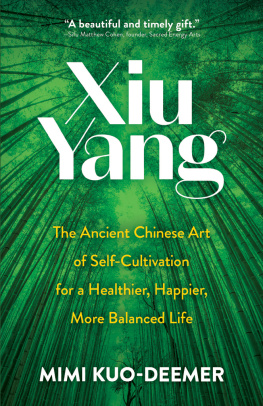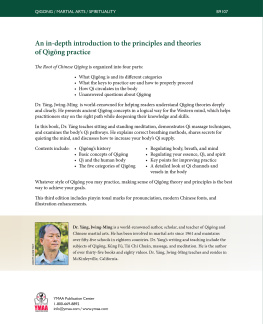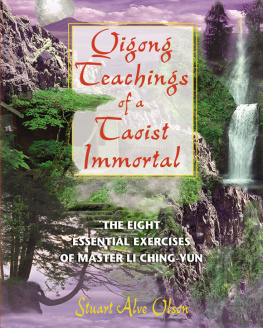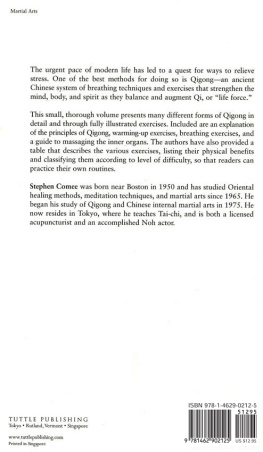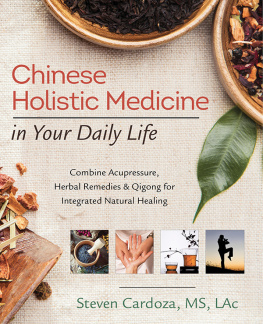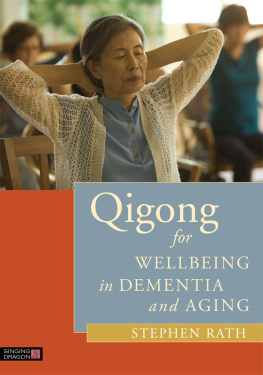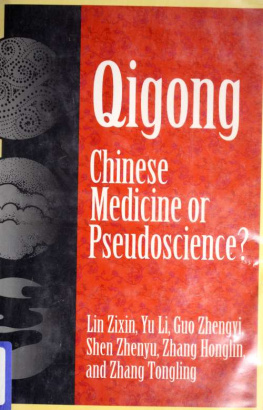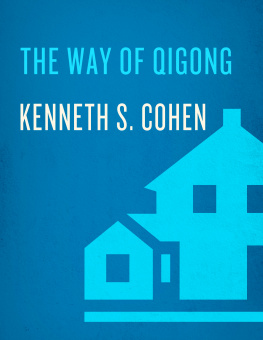

Copyright
Copyright 2018 by Mimi Kuo-Deemer
All rights reserved.
Image on page 52 courtesy of the Wellcome Collection.
Grateful acknowledgment is made for permission to reprint Chapter 9 [10 lines] from Tao Te Ching by Lao Tzu, A New English Version, with Foreword and Notes, by Stephen Mitchell. Translation copyright 1988 by Stephen Mitchell. Reprinted by permission of HarperCollins Publishers in the USA and Canada, and by permission of Pan Macmillan through PLSclear in all other territories.
Bibliographical Note
This Ixia Press edition, first published in 2019, is an unabridged republication of the work first published by Orion Spring, an imprint of The Orion Publishing Group Ltd, London, in 2018.
Library of Congress Cataloging-in-Publication Data
Names: Kuo-Deemer, Mimi, author.
Title: Qigong and the tai chi axis : nourishing practices for body, mind and spirit / Mimi Kuo-Deemer.
Description: Mineola : Ixia Press, 2019. | First published in Great Britain in 2018 by Orion Spring. | Includes bibliographical references. |
Summary: Reduce stress, release pain, and create bodily harmony with this introduction to qigong and the yin/yang balance of tai chi, the ancient Chinese arts of movement meditation. This accessible book features information about these practices as well as insights into their benefits, providing tools for replenishing inner resources and managing energy levels. It also offers advice on making healthier choices in everyday life that will support the bodys natural capacity for energy, balance, and well-being Provided by publisher.
Identifiers: LCCN 2019022551 | ISBN 9780486837376 (trade paperback)
Subjects: LCSH: Qi gong. | Tai chi.
Classification: LCC RA781.8 .K856 2019 | DDC 613.7/1489dc23
LC record available at https://lccn.loc.gov/2019022551
Ixia Press
An imprint of Dover Publications, Inc.
Manufactured in the United States by LSC Communications
83737801
www.doverpublications.com/ixiapress
2019
To my parents, grandparents, ancestors, and all who have come before me, back to the Source that is One.
CONTENTS
PART 1
WOOD ELEMENT: NOURISHING OUR ROOTS
PART 2
FIRE ELEMENT: NOURISHING THE HEART
PART 3
EARTH ELEMENT: NOURISHING THE MIND
PART 4
METAL ELEMENT: NOURISHING THE SPIRIT
PART 5
WATER ELEMENT: NOURISHING OUR DEEPEST WISDOM
CONCLUSION
TAI CHI AXIS AND THE DAO
FOREWORD
There is a word in Chinese called yuanfen that most directly translates as a fateful coincidence often seen when luck or destiny plays a role in bringing people together. This is how I would best describe my relationship with Mimi.
I met Mimi in 2003 when she walked into my class in Venice, California, where I was teaching my system of Sacred Energy Arts. She was like a beautiful koi fish with enormous eyes and watery movements keen on learning more about the intersection between hatha yoga and qigong. It was very clear that she was an intelligent, focused woman who was going to touch many peoples lives. We spoke at length after class and Mimi shared with me that she had opened her own school in Beijing and would like to have me come teach there. This was the beginning of our long and fortuitous relationship.
When I think of Mimi, I think of someone as a great connector. As a Chinese American who has lived and studied all over the world, she is a perfect ambassador to bridge the ancient teachings of the East with todays West. There is no better foundation than that of qigong.
Todays world is moving at a rapid pace we see this in technology, population growth, and consumption. We work longer hours. We work harder. We work faster. Sometimes these demands demand too much. We become overly stressed, tired, sick, and we neglect our internal life force our qi. We all have our own unique energetic signature, but unless we are willing to take the inner journey, the path is blocked, and we stray further from alignment with who we truly are. The qigong practice is the ancient Asian system of health and self-development that allows us to slow down, create s p a c e, and bring each of us back in harmony with our true Self.
Equanimity means to have a calm mind in difficult situations. This is a hallmark of qigong and tai chi practices. In Buddhism, it is described as having a mind like a clear lake. The demands of the world are not changing anytime soon, but we can change, and that change begins within.
The term dantian refers to our energy center in the body. It is where an acupuncture point known as the Sea of Qi resides. The journey we can take, traveling from the mind (or upper dantian) to the heart (or middle dantian) to the abdomen (or lower dantian), is one of the most sacred journeys we can take. This connection is the mindbody link from the cranium to the sacrum. This pathway is known in the world by many names. Qigong refers to this as the tai chi axis or zhong ding. In craniosacral circles it is known as the core link; in the Native American tradition it is the red road; in some Christian traditions it is ascension; in the yogic tradition it is the kundalini. This short physical distance of approximately three feet (one meter) is one of the most beautiful and important spiritual journeys available to us.
In this book you will find practices that can enrich your life and offer what the Chinese call radiant health, or health beyond danger. You will be guided with Mimis expert hands, words, wit and grace, and you will have the opportunity to enter the internal path of self-discovery to walk the red road. May your journey bring you joy, health and freedom.
Sifu Matthew Cohen
Founder of Sacred Energy Arts
PREFACE
Qigong (pronounced chee-gung) is a system of Chinese medicine that has helped transform peoples health and well-being for over 2,500 years. Over the 15 years I have practiced and taught qigong, I have seen how this ancient approach continues to benefit people, by providing tools with which to manage energy levels, regulate health and balance life.
As the popularity of qigong and tai chi extends beyond China and Asia, my aim is to reach across both cultures and present the wisdom from Chinese medicine and qigong in ways that contemporary Western readers can appreciate and find useful. I have also chosen to focus on how we can approach qigong as a fundamentally nourishing practice for the body, mind and spirit. Although qigong certainly takes patience and perseverance, it does not require as much strength or flexibility as some systems of movement-based practices such as yoga or martial arts. As an energy-based art, the power of qigong lies in its subtle potency. Most likely, you will find that even a few minutes of qigong a day can make you feel invigorated and relaxed.
Each part in Qigong and the Tai Chi Axis provides an overview of seasonal themes and characteristics of the Chinese Five Elements of Wood, Fire, Earth, Metal and Water as they relate to qigong practice. My intention is to give you greater context as to why certain qigong sequences and forms are beneficial. This way, as you learn to do the forms, you can track the specific benefit that each exercise offers your physical, mental and emotional health.
In most cases, I have used the worldwide standard of Pinyin to transcribe Chinese characters. In some instances, I have used the WadeGiles transcription, for words such as tai chi, for example, which is consistent with how most English speakers use and reference this term. The term tai chi means the point where yin and yang come into perfect balance. The tai chi axis is how we feel this balance in our bodies. The term tai chi chuan (taijiquan) is different. Many people often ask me what the difference is between qigong and tai chi chuan. The easiest way to explain the distinction is that tai chi chuan is a type of qigong practice: it follows set sequences that are martially based meditative movements. These sequences have been handed down primarily by five families and lineages in China the Yang, Wu Yi Xiang, Chen, Wu Jianquan and Hao-styled tai chi chuan. The forms in tai chi chuan are among the estimated 7,000 forms of qigong found in the world today.
Next page

